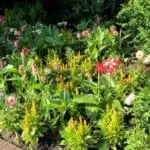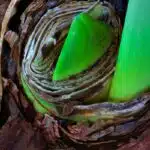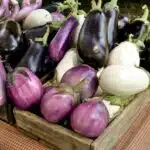Garlic, a member of the onion family, has been cultivated for centuries for its culinary and medicinal properties. Its pungent aroma and flavor add depth to dishes while its health benefits are widely acknowledged. Growing garlic is relatively easy, making it a perfect crop for beginner gardeners and seasoned horticulture enthusiasts alike. In this article, we will provide a comprehensive guide on how to plant, grow, and care for garlic so that you can enjoy the bountiful harvest of this versatile herb in your own backyard.
To successfully grow garlic, one must understand its preferred growing conditions and planting techniques. From selecting the right variety to preparing the soil, there are several crucial steps that need to be taken to ensure a healthy crop. Additionally, once the garlic is planted, proper care must be given throughout its growth cycle to prevent diseases and pests from damaging the plants. With our expert tips and advice, you’ll have all the information you need to successfully cultivate your own flavorful and nutritious garlic.
Why Garlic Is A Great Herb To Grow
Garlic is a versatile herb with numerous health benefits and culinary uses, making it an excellent addition to any garden. Garlic has been used for centuries as a natural remedy for various ailments, including high blood pressure and high cholesterol levels. It contains sulfur compounds that have antibacterial and antiviral properties, which can help prevent infections and improve overall immune function.
In addition to its health benefits, garlic is also a staple ingredient in many cuisines around the world. Its strong flavor adds depth and complexity to dishes, whether roasted, sautéed, or raw. Garlic can be used in soups, stews, sauces, marinades, and dressings. It pairs well with meats, vegetables, pasta dishes, and more.
Growing garlic in your garden is not only rewarding but also relatively easy. With the right care and attention, you can enjoy fresh garlic throughout the year. Whether you are a beginner gardener or an experienced one looking to expand your horizons, growing garlic is an excellent choice that offers both practical benefits and gastronomic pleasures.
As you begin planning your garlic garden project, consider which variety of garlic will work best for your needs. Different varieties have different flavors and growth habits that may suit your specific circumstances better than others. By choosing the right variety for your garden’s soil type and climate conditions from the start of your gardening journey with this herb will set you up for success before planting!
Choosing The Right Garlic Variety For Your Garden
Garlic variety selection is an essential aspect of growing garlic successfully. When selecting the garlic variety for your garden, consider factors like climate, soil type, and flavor preference. Some common types of garlic include softneck, hardneck, elephant garlic, and Creole garlic.
Softneck garlic varieties are best suited for regions with mild winters as they do not require a cold period to produce bulbs. Hardneck garlic varieties thrive in colder climates and produce large cloves that are easy to peel. Elephant garlic produces huge bulbs with a mild flavor and is ideal for roasting or grilling. Creole garlic does well in warm regions and has a spicy taste.
Soil preparation techniques are also crucial in ensuring that your chosen garlic variety thrives in your garden. Garlic grows best in well-draining soils that are rich in organic matter. Before planting, ensure that the soil is loose and crumbly by adding compost or aged manure to improve its structure. It’s also essential to test the soil pH levels and adjust them if necessary before planting.
Proper garlic variety selection and soil preparation techniques are critical for successful growth of this crop. Once you have selected the right variety for your region and prepared the soil correctly, it’s time to move on to preparing the site for planting your cloves.
Preparing The Soil For Garlic Planting
- Soil testing is an important step to take before planting garlic; a soil test can determine the amount of organic matter, pH levels, and nutrient content in the soil.
- If the soil is found to be deficient in organic matter or nutrients, amendments can be added to the soil in order to reach the desired levels for successful garlic growth.
- To ensure proper nutrient availability for the garlic plants, adding well-rotted manure or compost to the soil is recommended before planting the garlic.
- Additionally, it is important to adjust the soil pH to 6.0 to 7.0 by adding lime, as garlic grows best in soil that is slightly acidic.
Soil Testing
To ensure optimal growth and yield of garlic, it is essential to start by preparing the soil. One crucial step in this process is soil testing. Measuring the pH of the soil is an important aspect of this analysis. Garlic thrives in a pH range of 6.0 to 7.5, so it’s imperative to test the soil to ensure that it falls within this range. If the pH is too acidic or alkaline, then it can lead to stunted growth and lower yields.
In addition to measuring pH, nutrient analysis is another critical component of soil testing for growing garlic successfully. Garlic requires adequate amounts of nutrients such as nitrogen, phosphorus, and potassium for optimum growth and development. A nutrient analysis will provide insights into whether your soil has sufficient levels of these essential nutrients or if you need to add more through fertilization.
Overall, knowing what your soil needs before planting garlic can make a significant difference in its overall health and productivity. Soil testing allows you to identify any potential issues with acidity, nutrient deficiencies or excesses that may hinder proper growth or reduce yield potential. With proper preparation, you can create an optimal environment for your garlic crop to thrive and produce high-quality bulbs rich in flavor and nutrition.
Soil Amendments
After performing a soil analysis, the next step in preparing the soil for planting garlic is to consider soil amendments. Soil amendments are materials added to the soil to improve its physical and chemical properties. One of the most popular soil amendments for garlic cultivation is composting. Composting benefits include improving soil structure, increasing water retention, and adding organic matter that contains essential nutrients like nitrogen, phosphorus, and potassium.
Organic fertilizers are another type of soil amendment that can be used when preparing the soil for planting garlic. Organic fertilizers come from natural sources such as animal manure or plant by-products. These fertilizers provide slow-release nutrients that promote healthy growth without harming the environment or causing excessive runoff. Using organic fertilizers also helps to maintain healthy populations of beneficial microorganisms in the soil.
When choosing a soil amendment for your garlic crop, it’s important to consider factors such as the pH level of your soil and nutrient deficiencies identified through a soil analysis. Using composting or organic fertilizers can help to improve overall soil health and create an optimal growing environment for your garlic crop. By taking these steps before planting, you can ensure that your garlic will thrive and produce high-quality bulbs with maximum flavor and nutrition content for consumption.
Understanding The Best Time To Plant Garlic
After preparing the soil for garlic planting, it’s essential to determine the best time to start your garlic growing process. Like a sailor navigating the ocean and reading the stars for direction, gardeners must observe weather patterns and temperature changes to determine the ideal planting time. The best time to plant garlic is in the fall when soil temperatures drop below 60°F but before the ground freezes.
Choosing the right garlic variety for your climate is crucial in ensuring success. In colder climates, hardneck varieties are ideal as they can withstand harsh winters, while softneck varieties thrive in warmer areas. Some of the most popular hardneck varieties include German White, Chesnok Red, and Music Garlic. Meanwhile, softneck varieties like California Early and Inchelium Red are known for their excellent flavor and aroma.
Maintaining soil moisture during planting is another critical factor in growing healthy garlic plants. The key is to keep the soil moist but not waterlogged. Overwatering can lead to root rot and other diseases that can harm your crops. To maintain optimum soil moisture levels, consider adding organic matter like compost or mulch into your soil mix.
Planting garlic in rows or clumps is a common practice among gardeners; however, there are pros and cons to both methods. Planting in rows allows you to space out each bulb evenly while making weeding easier. On the other hand, planting in clumps provides natural protection from pests while maximizing space utilization. Ultimately, it depends on your preference and available resources. Regardless of which method you choose, ensure that each clove is planted at least two inches deep with their pointed side facing up.
With these tips in mind, you’re now ready to start your garlic-growing journey successfully!
Planting Garlic In Rows Or Clumps
When planting garlic, there are two main spacing options to choose from: rows or clumps. Both methods have their advantages, and which one you choose will depend on your personal preference and the amount of space you have available in your garden.
For those who have ample space, planting garlic in rows is a popular option. This method involves digging a trench about 6 inches deep and spacing the cloves about 6 inches apart within the trench. Then, cover the cloves with soil and water thoroughly. Planting in rows allows for easy access between plants, making it easier to weed and harvest the garlic later on.
Alternatively, planting garlic in clumps is a great option for those with limited space or who want a more decorative look in their garden. Simply dig holes about 4-6 inches deep and place several cloves together in each hole, spacing each hole about 4-6 inches apart. Cover with soil and water thoroughly. Companion plants such as chives or onions can be planted around the edges of the clump to help deter pests.
By considering both spacing options and companion plants when planting garlic, you can create a healthy environment for your crop that will yield delicious results come harvest time. In order to ensure that your garlic grows strong and healthy, it is also important to properly water them throughout their growing season.
Watering Garlic Properly
After planting garlic in rows or clumps, the next important step is to water them properly. Garlic requires consistent moisture throughout its growing cycle, but overwatering can lead to disease and inhibit bulb development. To avoid these problems, it is best to use drip irrigation as it delivers water directly to the root zone of the plants while minimizing evaporation.
Drip irrigation ensures that the soil around the garlic stays moist without becoming waterlogged. This method also helps prevent fungal diseases from spreading since the foliage of the plant remains dry. Overhead watering, on the other hand, can create a humid environment that encourages fungal growth and increases the risk of disease. Therefore, using drip irrigation is essential for maintaining healthy garlic plants.
Despite needing consistent moisture, garlic does not require excessive watering. Overwatering can cause bulbs to rot and delay maturity. It is important to monitor soil moisture levels regularly and only irrigate when necessary. A good rule of thumb is to wait until the top inch of soil feels dry before watering again. By avoiding overwatering and using drip irrigation, you can ensure optimal growth for your garlic crop.
Transition: Proper watering techniques are crucial for growing healthy garlic plants; however, another vital aspect that plays a significant role in achieving optimal yields is fertilization.
Fertilizing Garlic For Optimal Growth
Achieving optimal growth for garlic requires proper fertilization. Using organic fertilizers is highly recommended as it promotes the natural growth of garlic plants without the use of harmful chemicals. Organic fertilizers are made from natural materials such as compost, manure, and bone meal. These materials provide essential nutrients required by garlic plants to grow well.
Another critical factor in fertilizing garlic is crop rotation. Crop rotation involves planting different crops in the same soil to prevent soil depletion and improve soil structure. This practice helps to boost the fertility of the soil and prevent diseases that can affect garlic growth. By rotating crops, you can avoid planting garlic continuously in the same area, which can lead to a reduction in yield due to soil depletion.
By using organic fertilizers and practicing crop rotation, you can promote optimal growth for your garlic plants. These practices help to maintain healthy soil conditions, provide essential nutrients required for plant growth and prevent diseases that can affect plant health. In the next section, we will discuss how mulching your garlic beds can further enhance the growth and development of your garlic plants.
How To Mulch Garlic Beds
After applying the right type and amount of fertilizer to your garlic plot, the next step is to prepare your garden for mulching. Mulching is a crucial aspect of garlic cultivation as it provides numerous benefits that help ensure optimal growth and yield. For one, mulching helps regulate soil temperature by keeping the soil cool during hot weather and warm during cold weather. Additionally, it helps retain moisture in the soil, reducing water stress on your garlic plants.
There are different types of mulch materials that you can use when cultivating garlic. Organic mulches such as straw, hay, or leaves are an excellent choice as they decompose slowly and add nutrients to the soil over time. Inorganic materials like plastic or landscape fabric are also suitable for mulching but require careful management to avoid negatively impacting the surrounding environment. Whatever material you choose, ensure that you apply it evenly around each plant while leaving a small area around the stem uncovered.
Properly managing pests and diseases is critical in ensuring healthy garlic growth through harvest time. Some common pests that affect garlic include onion thrips, nematodes, bulb mites, and cutworms. Diseases such as white rot, downy mildew, purple blotch, and rust can also impact garlic growth if not appropriately addressed. To minimize infestations and infections within your garden plot, practice good sanitation habits such as removing dead plant debris regularly and rotating crops yearly. Planting disease-resistant varieties or using organic pest control methods may also help prevent issues from arising altogether.
Managing Garlic Pests And Diseases
- Garlic is susceptible to various pests and diseases, and it is important to identify them in order to successfully manage them.
- Controlling pests and diseases in garlic involves the use of cultural practices such as crop rotation, destroying infected plants, and proper sanitation.
- Disease-resistant varieties of garlic can be selected for planting to reduce the risk of diseases, and careful selection of planting sites can help reduce the risk of pest infestations.
- Additionally, chemical controls such as fungicides and insecticides can also be used for managing pests and diseases in garlic, although these should be used with caution to avoid damaging beneficial organisms.
Identifying Pests And Diseases
As a gardener, identifying pests and diseases on your garlic plants is crucial to ensure their healthy growth. Prevention measures should be taken to avoid the occurrence of these problems. One of the most effective ways is to maintain good soil quality by adding organic matter, which will help regulate soil moisture and nutrient levels. Avoid overwatering, as this can lead to fungal infections that can damage the plants. It is also important to rotate crops annually to prevent the buildup of pests and diseases in the soil.
Despite prevention measures, garlic plants may still experience pests and diseases. The most common pests that attack garlic are aphids, thrips, nematodes, and onion maggots. These pests can cause significant damage to the plant by stunting its growth or even killing it. Natural remedies such as insecticidal soap or neem oil can be used for controlling these pests while minimizing harm to beneficial insects. Diseases such as white rot or rust can also affect garlic plants; removing infected leaves and practicing crop rotation can help prevent further spread.
In conclusion, identifying and preventing pests and diseases is essential for maintaining healthy garlic plants. Regular monitoring of your garden will help you catch any issues before they become severe. By incorporating prevention measures and natural remedies, you can keep your garlic growing strong throughout its growing season. Remember that gardening is an ongoing process of learning and adapting – stay curious about new techniques and approaches that may benefit your garden!
Controlling Pests And Diseases
Controlling pests and diseases is a critical aspect of managing garlic plants. Prevention measures are necessary, but sometimes pest and disease issues can still arise. Therefore, it is essential to be prepared with natural pest control methods that can help manage the problem without causing harm to beneficial insects or the environment.
Preventing rot is one of the most important things you can do to keep your garlic plants healthy. White rot is a fungal disease that thrives in wet conditions and can cause significant damage to garlic bulbs, leading to crop failure. To prevent this from happening, it is crucial to avoid overwatering and ensure good soil drainage. You can also use organic mulch around the base of the plants to help regulate soil moisture levels.
Natural pest control methods are an effective way to manage pests while keeping your garden safe for beneficial insects like bees and ladybugs. Insecticidal soap or neem oil are two natural remedies that work well against common pests like aphids, thrips, nematodes, and onion maggots. These remedies should be applied early in the growing season when pests are typically less prevalent. Additionally, practicing crop rotation each year will help prevent pests from building up in the soil and causing problems for future crops.
Harvesting Garlic At The Right Time
As you patiently wait for your garlic to mature, it is important to determine when it is ready for harvesting. You will know that your garlic is mature and ready for harvest when the leaves start to turn yellow and dry up. The bottom leaves of the garlic plant are usually the first ones to dry up, so keep an eye on them.
Another sign of ready-to-harvest garlic is when the bulbs have developed their papery outer layer. This protective layer helps to shield the garlic from pests, diseases, and other environmental factors. To check if your garlic has reached maturity, gently dig around one or two plants with a garden fork or spade. Carefully brush off any soil from the bulbs and examine their size and color.
When you have determined that your garlic is mature and ready for harvest, it’s time to carefully pull out each bulb by hand or use a garden fork to loosen the soil around them. Once harvested, shake off any excess soil but do not wash them as this can damage their protective layer. In the next section, we will discuss how to cure and store your freshly harvested garlic bulbs so that they last longer.
Curing And Storing Garlic
Garlic storage is a crucial aspect of garlic cultivation, as it ensures that the bulbs remain viable for an extended period. Once harvested, garlic must be cured and stored correctly to prevent spoilage and preserve flavor. Curing involves drying the garlic bulbs in a warm, dry place for several weeks until they are completely dry.
There are various garlic curing techniques, but the most common involves tying the bulbs together in bunches and hanging them in a well-ventilated area. The ideal temperature for curing garlic is between 60-70°F (15-21°C), with humidity levels below 60%. It’s essential to avoid direct sunlight during the curing process as it can bleach the outer layers of the bulbs.
Once fully cured, store the garlic bulbs in a cool, dark place with good airflow. A pantry or root cellar is an excellent option for storing garlic as they provide stable temperatures and humidity levels. Garlic can last up to six months when stored properly. However, it’s essential to check on your stored garlic regularly and remove any sprouting or rotting cloves promptly.
In summary, proper garlic storage begins with curing. With attention to detail during this process, you can achieve flavorful and long-lasting bulbs that will serve you well throughout the year. In our next section, we’ll discuss how to save your best garlic bulbs for planting next season without compromising quality or yield.
Saving Garlic Bulbs For Next Season
After curing and storing garlic, it is important to preserve the bulbs for the next planting season. Garlic propagation is an essential part of growing garlic, and saving bulbs allows gardeners to replant them in the fall or spring. To preserve garlic bulbs, remove any excess dirt and debris from them and store them in a cool, dry place. The ideal temperature range for storing garlic is between 32-40°F with a relative humidity of 65-70%.
One effective way to save garlic bulbs is by braiding them together. This not only makes storage easier but also adds a decorative touch to your kitchen or pantry. To braid garlic, start by gathering three bulbs with long stalks. Braid the stalks together as you would with hair, adding more bulbs as you go until you have a length that suits your needs. Tie off the end with twine or ribbon and hang it in a cool, dry spot.
By preserving your garlic bulbs properly, you can ensure a healthy crop year after year. Keep in mind that when planting saved bulbs, they may produce smaller cloves than fresh ones. It’s also important to rotate your planting location each year to prevent soil-borne diseases from building up over time. With these tips in mind, you can enjoy fresh garlic straight from your garden for years to come.
Moving on from saving garlic for planting purposes, using garlic in cooking and home remedies is an age-old practice that has many health benefits. Whether it’s adding flavor to dishes or treating ailments such as colds and infections, there are countless ways to incorporate this versatile herb into your daily routine.
Using Garlic In Cooking And Home Remedies
Garlic is not only a staple ingredient in many cuisines around the world, but it also has numerous health benefits. It contains antioxidants that help protect against cell damage and reduce the risk of chronic diseases such as heart disease and cancer. Additionally, garlic has antibacterial and antiviral properties that may help boost the immune system.
Apart from its culinary uses, garlic can also be used in various DIY remedies. For example, it can be crushed and mixed with honey to create a natural cough syrup or added to olive oil to make an antibacterial ear drop solution. Garlic can also be applied topically to treat fungal infections like athlete’s foot or nail fungus.
When using garlic for health purposes, it is important to note that consuming too much raw garlic may cause stomach upset or bad breath. Therefore, it is recommended to start with small amounts and gradually increase over time. Additionally, some people may have allergies or sensitivities to garlic, so it is best to consult with a healthcare provider before using it as a remedy.
Next, we will discuss frequently asked questions about growing garlic such as when to plant, how often to water, and how long until harvest.
Frequently Asked Questions About Growing Garlic
Growing garlic requires well-drained soil with a pH level of 6-7, as well as full sun exposure and adequate moisture. Planting is best done in early spring or fall, while bulbs should be spaced around 6-8 inches apart. Harvesting should occur at the right time, when the bottom leaves have yellowed, and the garlic should be stored in a cool, dry, and dark place. Finally, proper care during the growing season, such as regular weeding and watering, is essential for successful garlic cultivation.
Planting Requirements
As a horticultural specialist, it is important to understand the planting requirements for garlic. Garlic is an easy-to-grow perennial plant that requires well-draining soil, plenty of sunlight, and moderate watering. The optimal time to plant garlic is in the fall, 4-6 weeks before the first frost. To begin planting garlic, choose a sunny location with fertile soil and work in compost or other organic matter to enrich the soil.
Planting depth plays a crucial role in the growth of garlic. Plant each clove 2-3 inches deep and 4-6 inches apart in rows that are spaced at least 12 inches apart. The pointed end of each clove should face upwards while the flat end faces downwards. Press each clove firmly into the soil and cover with approximately 1 inch of soil.
Spacing requirements are also important when planting garlic. Planting too closely together can lead to overcrowding and stunted growth. Adequate spacing allows for proper air circulation and reduces the risk of disease spread among plants. It is recommended to space cloves at least 4-6 inches apart within rows, with rows spaced at least 12 inches apart from one another. By following these guidelines for planting depth and spacing requirements, you can ensure optimal growth and harvest of your garlic crop without any issues or setbacks.
Harvesting & Storage
Once you have successfully planted garlic, the next step is to learn about harvesting and storage. Garlic is typically ready to harvest in late spring or early summer, depending on your planting time and growing conditions. To determine if your garlic is ready for harvest, check the leaves and stems for signs of yellowing or drying out. When the bottom three leaves have turned brown and the top three leaves are still green, it’s time to begin harvesting.
To harvest garlic, use a garden fork or spade to gently loosen the soil around each plant. Be careful not to damage the bulbs as you lift them from the ground. Brush off any excess dirt and allow the garlic to dry in a warm, well-ventilated area for 2-3 weeks. Once fully dried, trim off any remaining roots or leaves and store in a cool, dry place.
When it comes to storage, there are several options available. You can store garlic bulbs loose in a mesh bag or basket in a cool pantry or basement with good air circulation. Alternatively, you can braid garlic into decorative plaits for easy storage and display. Another option is to chop or mince fresh garlic and freeze it in an ice cube tray for convenient use in cooking. Garlic scapes, which are thin curly shoots that grow from hardneck varieties of garlic plants, can also be harvested before they flower and used in recipes like pesto or pickled for later use. By following these tips for proper harvesting and storage of your garlic crop, you can enjoy its flavorful benefits all year round!
Troubleshooting Common Garlic Growing Problems
Growing garlic can be likened to sailing a ship through rough waters. Just like navigating unpredictable currents and waves, garlic cultivation has its own set of challenges. These common garlic problems can hinder the growth and development of your plants, but with proper troubleshooting tips, you can overcome them and achieve a bountiful harvest.
One of the most prevalent issues in garlic growing is fungal diseases such as white rot and rust. White rot causes the leaves to wilt, while rust produces reddish-brown spots on the foliage. To prevent these diseases from spreading, it’s important to rotate crops yearly and avoid planting in areas that have previously been infected. Additionally, applying fungicides during the early stages of growth can help reduce the risk of infection.
Another issue that gardeners often encounter is poor soil quality. Garlic thrives in well-draining soil that is rich in organic matter. If your soil lacks nutrients or has poor drainage, your garlic may not grow to its full potential or develop bulbils at all. To remedy this problem, amend your soil with compost or other organic materials before planting and make sure to water consistently but not excessively.
In conclusion, growing garlic can be a rewarding experience if done correctly. By being aware of common garlic problems such as fungal diseases and poor soil quality, you can take steps to troubleshoot these issues effectively. With patience and diligence, you’ll soon be enjoying a bountiful harvest of delicious homegrown garlic!
Conclusion
Garlic is an herb that has been used for centuries in cooking and home remedies due to its unique flavor and health benefits. Growing garlic can be a fun and rewarding experience for any gardener, especially those who enjoy cooking with fresh ingredients. When planting garlic, it is important to choose the right variety for your garden, prepare the soil properly, and understand the best time to plant.
Planting garlic can be done in rows or clumps, depending on personal preference and available space. It is also essential to know how to save bulbs for next season and incorporate garlic into cooking and home remedies. Common problems such as pests or diseases may arise during the growing process, but with proper care and attention, these issues can be avoided.
In conclusion, growing garlic is a great way to enhance your culinary skills while enjoying the numerous health benefits of this versatile herb. With the right preparation and knowledge of planting techniques, anyone can grow delicious garlic in their own backyard. Remember that gardening takes patience, but with careful attention and regular maintenance, your garlic crop will thrive. As the saying goes: “The best time to plant a tree was 20 years ago; the second-best time is now.” So start planting your garlic today!
Image Credits
- “Garlic Bread” by mdid (featured)





























